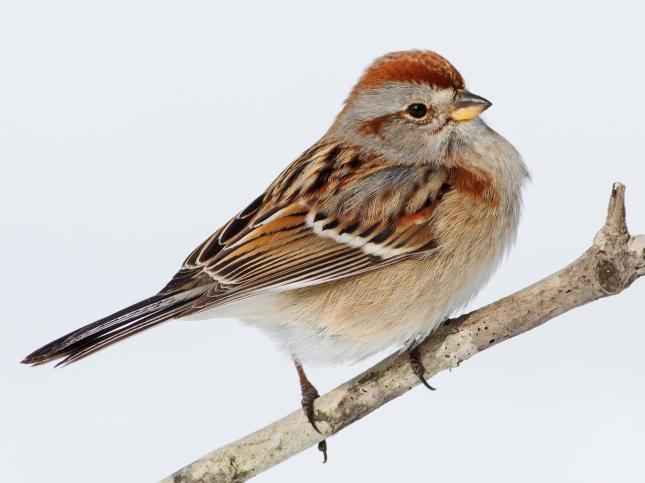
Fun Facts About American Tree Sparrows
- Plump and long-tailed, American Tree Sparrows are busy visitors in winter backyards and weedy, snow-covered fields across southern Canada and the northern United States. Hopping up at bent weeds or even beating their wings to dislodge seeds from grass heads, they scratch and peck the ground in small flocks, trading soft, musical twitters. Come snowmelt, these small rusty-capped and smooth-breasted sparrows begin their long migrations to breeding grounds in the tundra of the far North.
- Winter is the time to go looking for American Tree Sparrows. Small flocks converge on snow-swept fields and bird feeders, where they feast on seeds on the ground. Here their bicolored bill and central breast spot help them stand out from other sparrows. Despite their name, you'll probably find them foraging on the ground rather than feeding in trees.
- American Tree Sparrows eat seeds, berries, and insects, but the relative proportions of those foods change radically from winter to summer months. From fall through spring, they're almost exclusively vegetarian, eating grass, sedge, ragweed, knotweed, goldenrod, and other seeds, as well as occasional berries, catkins, insects, insect eggs, and larvae. In settled areas, they happily eat small seeds from feeders—including millet scattered on the ground. In summer, after their migration north, they begin eating a wider and wider variety of insects until, during June and July they eat almost exclusively insects such as beetles, flies, leafhoppers, wasps, moths, and caterpillars, as well as spiders and snails.
- American Tree Sparrows nest on or near the ground, often in a tussock of grass at the base of a shrub, occasionally as high as about 4 feet on a limb of a willow or spruce. In open tundra with no trees in sight, the nest may sit on a mossy hummock.
- The oldest recorded American Tree Sparrows was at least 10 years, 9 months when it was recaptured and rereleased during banding operations in Connecticut in 1983.
- American Tree Sparrows need to take in about 30 percent of their body weight in food and a similar percentage in water each day. A full day's fasting is usually a death sentence. Their body temperature drops and they lose nearly a fifth of their weight in that short time

